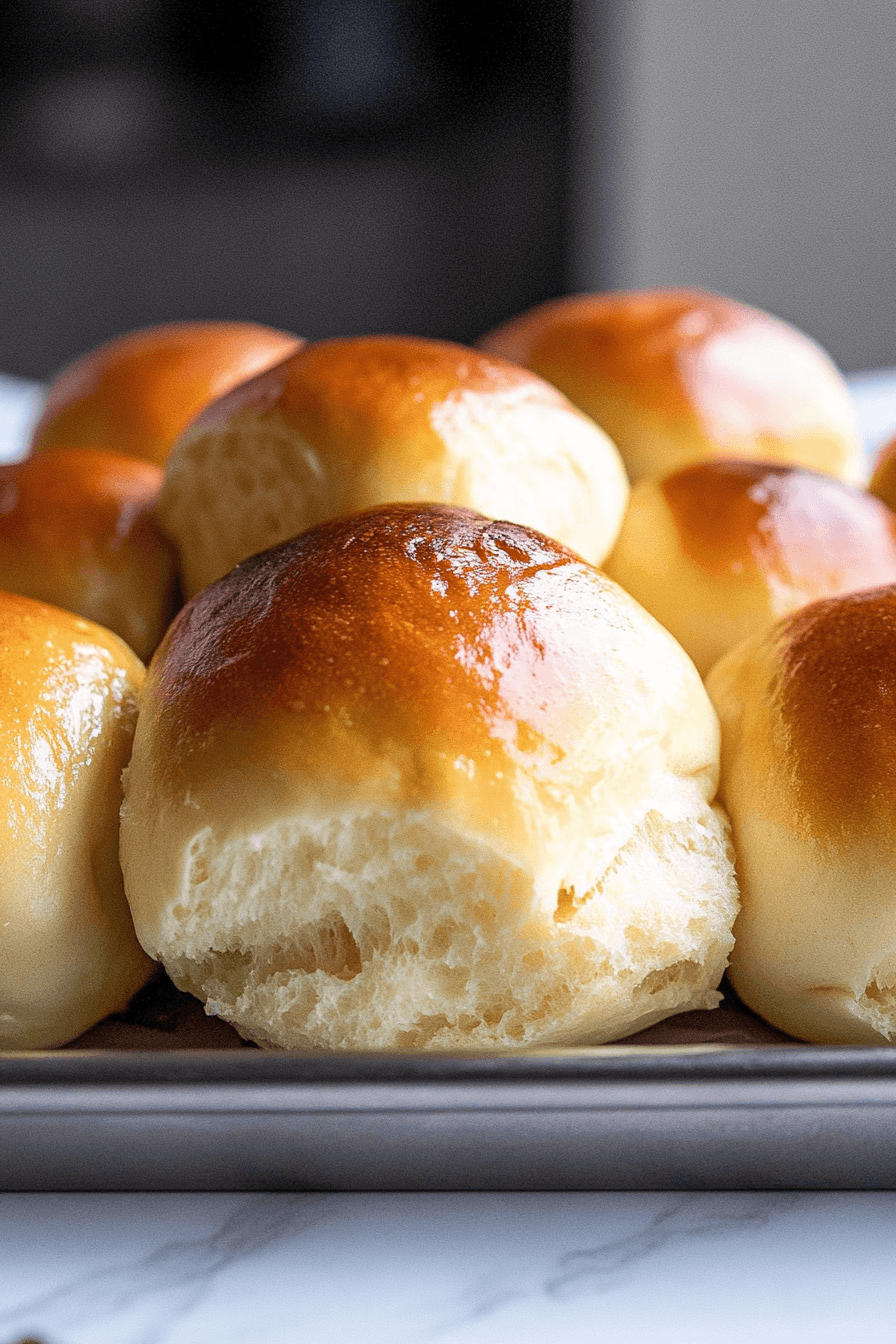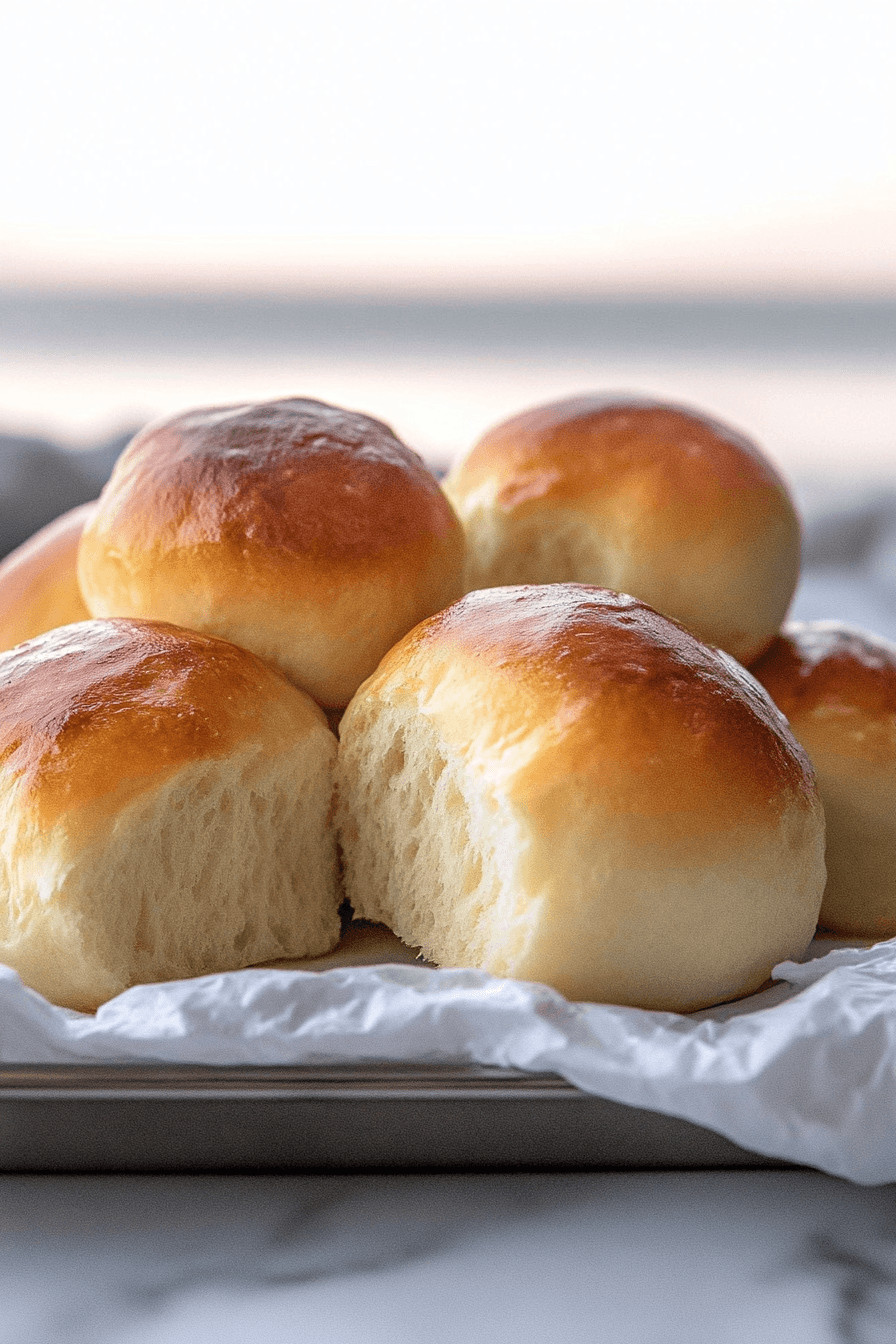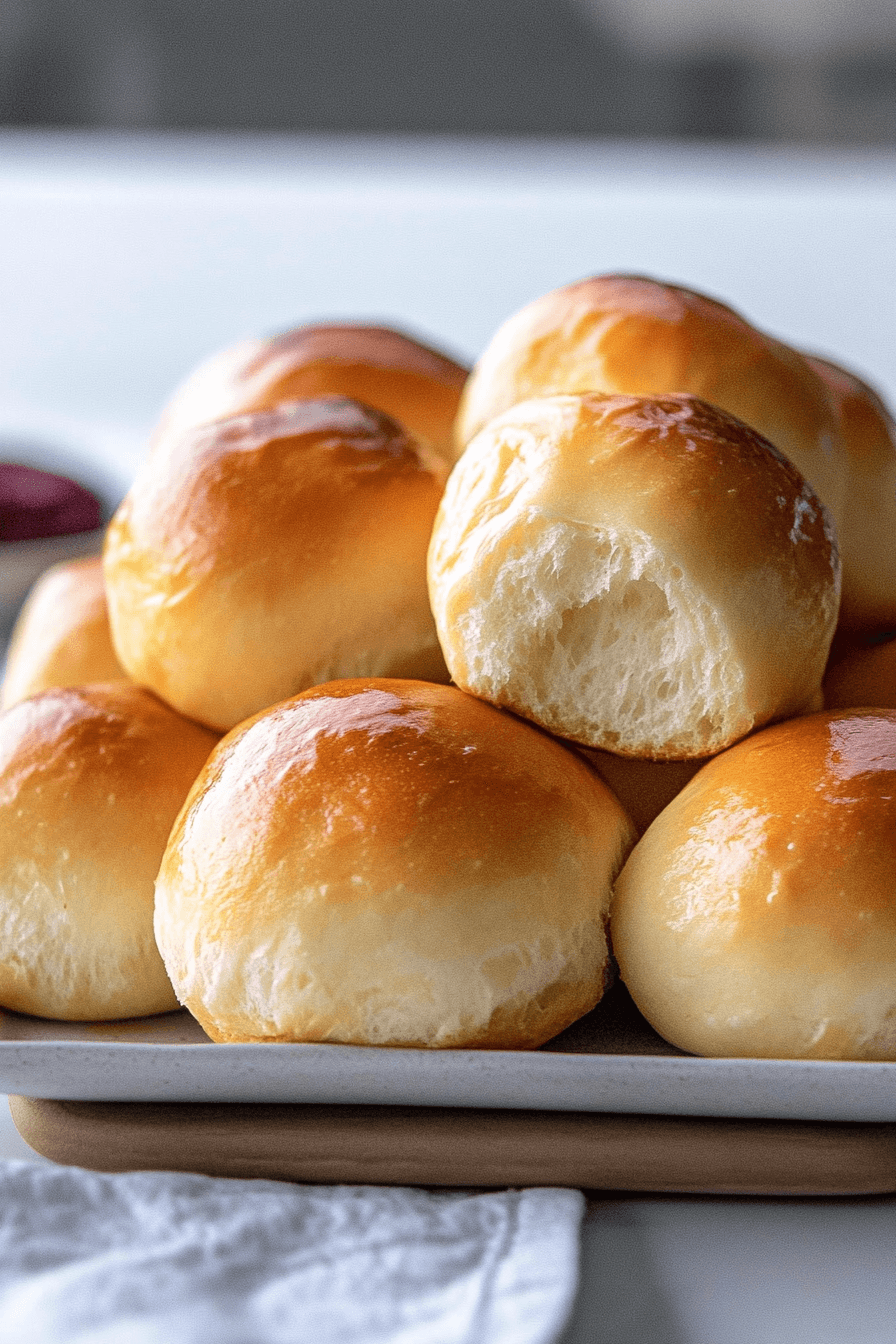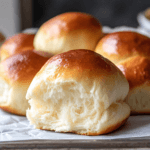Introduction to Soft Dinner Rolls
Imagine savoring the warmth of a freshly baked, fluffy dinner roll that’s soft enough to melt in your mouth. Soft dinner rolls are not just a delight for your taste buds; they’re also remarkably simple to make, offering a recipe that welcomes both beginners and experienced bakers alike. Available in vegan and gluten-free variations, these rolls cater to diverse dietary preferences, ensuring everyone at your table can enjoy them. With a subtle sweetness, they complement any meal, making them a must-have in every baker’s repertoire. Discover the joy of baking these soft dinner rolls today!
Benefits and Advantages of Soft Dinner Rolls
Soft dinner rolls offer a delightful blend of simplicity and taste, making them a preferred choice for many meals. Their easy preparation allows even busy parents or students to whip up a batch without hassle. Besides being a comforting addition to any dinner table, their health benefits can’t be overlooked, especially when made with whole grains or low-calorie ingredients. They stand out because of their versatile nature, adapting easily to dietary needs and meal themes. Their soft texture and slightly sweet flavor make them a beloved choice for both everyday dinners and festive gatherings alike.

Ingredients Overview
Essential Ingredients for Soft Dinner Rolls
- All-Purpose Flour: 3 ½ cups. Flour provides the structure of the rolls. For those interested in gluten-free options, almond flour can be a viable alternative, though it alters the texture slightly.
- Active Dry Yeast: 2 ¼ teaspoons. Yeast is a leavening agent that helps the dough rise, providing the signature fluffiness.
- Sugar: ¼ cup. This adds just the right amount of sweetness. Feel free to use alternative sweeteners like honey or agave syrup for a unique flavor.
- Salt: 1 teaspoon. Enhances the overall taste, balancing the sweetness and enriching flavor profiles.
- Milk: 1 cup, warmed to about 110°F. It activates the yeast. You can substitute with plant-based milk for a vegan option.
- Butter: ¼ cup, melted. Provides moisture and a buttery softness. Vegan butter can replace regular butter here.
- Egg: 1 large, at room temperature. Adds richness and binds the ingredients. For a vegan version, a flaxseed egg can be substituted.
Dietary Substitutions to Customize Your Soft Dinner Rolls
Soft dinner rolls are incredibly versatile and can be tailored to meet various dietary preferences:
- Gluten-Free: Substitute all-purpose flour with a gluten-free flour blend. Ensure the blend contains xanthan gum for structure.
- Vegan: Use plant-based milk such as almond, soy, or oat. Substitute the egg with a flaxseed meal egg (1 tablespoon flaxseed meal + 3 tablespoons water).
- Low-Carb: While flour is pivotal in rolls, you can reduce carbs by experimenting with almond or coconut flour, keeping in mind the texture changes.
For additional experimentation, herbs like rosemary or thyme can be infused into the dough, adding an aromatic twist. Similarly, cheese or seeds can be sprinkled before baking for an exciting flavor burst. Balance these adjustments with taste and functional needs to maintain the integrity and delightful nature of these soft dinner rolls, perfect for multiple occasions.
How to Prepare the Perfect Soft Dinner Rolls: Step-by-Step Guide
First Step: Preparing the Dough
To create soft dinner rolls, begin by activating your yeast. In a small bowl, mix warm milk with sugar, then add the active dry yeast. Allow this mixture to sit untouched for about 5 minutes until it becomes frothy—this signals that the yeast is active and ready to work its magic. Meanwhile, in a large mixing bowl, combine the flour and salt.
Second Step: Mixing Ingredients
Once your yeast is activated, pour the yeast mixture into the flour and salt combination. Add your melted butter and the egg, mixing it all together until you form a sticky dough. You can use a stand mixer for this process on a medium speed setting, or mix by hand, ensuring that the ingredients are thoroughly incorporated. Kneading will develop gluten, which is essential for the rolls’ soft texture.
Third Step: Kneading and Resting
Turn the dough onto a floured work surface and gently knead it for about 10 minutes until smooth and elastic. If the dough is sticky, add a little more flour, but be cautious not to add too much as this can make the rolls dense. Once kneaded, place the dough in a greased bowl, cover it with a kitchen towel, and let it rise in a warm place for approximately 60 minutes, or until it has doubled in size—proper proofing ensures the rolls are light and airy.
Fourth Step: Shaping the Rolls
Once your dough has risen, punch it down to release air before dividing it into 12 equal pieces. Shape each piece into a ball by tucking the edges underneath and cupping your hand over it, creating a smooth surface. Arrange these dough balls evenly on a greased baking pan or sheet.
Fifth Step: Final Rise and Baking
Cover the shaped rolls with a kitchen towel and allow them to rise once again, for about 30 minutes, until they expand in size. Preheat your oven to 375°F. Before baking, brush the rolls with melted butter for an extra-rich crust. Bake for 15-20 minutes or until golden brown on top.
Sixth Step: Serving the Rolls
Once baked, remove the rolls from the oven and optionally brush again with more butter for a glossier finish. Serve these fluffy rolls warm, perhaps alongside hearty dishes like ground beef rice burrito bowls or comforting French onion soup rice for a classic and satisfying meal experience.
This method allows flexibility for diet-conscious bakers, accommodating substitutions for health-specific needs, while still enjoying the homemade delight of soft, fluffy dinner rolls.

Mastering Soft Dinner Rolls: Advanced Tips and Variations
Creating perfect soft dinner rolls every time requires the mastery of a few advanced techniques and some delightful variations. Whether you’re a seasoned baker or just starting, these tips will ensure your rolls are consistently irresistible.
Advanced Tips for Perfect Soft Dinner Rolls
- Temperature Control: Ensure that the yeast is activated in a warm liquid, preferably at 110°F. This temperature sweet spot optimizes the yeast activity, producing fluffy rolls.
- Proper Kneading: Kneading the dough until it’s smooth and slightly elastic is essential. This process builds the gluten network necessary for the airy structure of the rolls.
- Accurate Proofing: Allow the dough to rise in a warm, draft-free location. The first rise should double the dough’s size, a crucial step for developing flavor and structure.
- Butter Brush: For an extra rich flavor, brush the rolls with melted butter immediately after baking. This addition adds a beautiful shine and deepens the taste.
Delicious Variations to Try
Variety is the spice of life, and the same applies to soft dinner rolls. Try incorporating these variations to bring novel flavors to your table:
- Herb-Infused: Add parsley, rosemary, or thyme to the dough for a savory touch. This variation is perfect for pairing with hearty soups or roasted meats.
- Potato Rolls: Substitute some of the flour with mashed potatoes. This switch results in even softer rolls with a slightly sweet finish.
- Whole Wheat Option: Replace half the all-purpose flour with whole wheat flour. This version is healthier and has a nutty flavor that’s appealing.
- Cheese Topping: Sprinkle shredded cheese on top of the rolls before baking. This addition creates a golden, crispy topping that’s both savory and enchanting.
These advanced tips and variations not only enhance the diversity of your soft dinner rolls but also make them a staple in any mealtime setting. These adaptable rolls can be served alongside dishes like garlic butter chicken with lemon parmesan pasta for a delightful dining experience.
How to Store Soft Dinner Rolls: Best Practices
Proper storage extends the life and maintains the freshness of your soft dinner rolls. Here are the best practices for refrigeration, freezing, and reheating:
Refrigeration Tips
If you plan to eat the rolls within a couple of days, store them in an airtight container or zip-top bag at room temperature. Avoid refrigerating rolls as it can dry them out and dull their taste.
Freezing Soft Dinner Rolls
For longer storage, freezing is an excellent option. Allow the rolls to cool completely before transferring them to a freezer-safe bag or an airtight container. Thaw the rolls at room temperature before serving. To enjoy that freshly baked taste, warm them in the oven for a few minutes at 350°F.
Reheating Techniques
To regain the original softness, wrap the rolls in aluminum foil and place them in a preheated oven at 300°F for around 10-15 minutes. This reheating method ensures they retain their moisture and fluffy texture.
For those who bake ahead, soft dinner rolls can be easily incorporated into recipes like French onion short rib soup with cheesy Gruyere toast. Following these storage methods ensures your rolls remain delightful, ready to accompany your favorite dishes.

Nutritional Value of Soft Dinner Rolls
Soft dinner rolls are not only a delightful addition to your meal but also come with a variety of nutritional benefits. Understanding their nutrition profile can help you manage your dietary needs while enjoying these fluffy treats. The primary components of soft dinner rolls include flour, milk, butter, and yeast, all of which contribute to their health profile.
Each roll typically contains around 100-150 calories, depending on size and ingredients used. Here’s a breakdown of their basic nutritional content:
| Nutrient | Average Amount per Roll |
|---|---|
| Calories | 100-150 kcal |
| Carbohydrates | 18-22 grams |
| Protein | 3-4 grams |
| Fat | 2-3 grams |
| Fiber | 1 gram |
| Sugars | 1-2 grams |
| Sodium | 150-200 mg |
The carbohydrates in these rolls provide a quick source of energy, while the protein aids in muscle repair and growth. The fat content is relatively low, especially if using lighter dairy alternatives or plant-based butter. The inclusion of some fiber and essential vitamins like B-vitamins from the flour adds to the rolls’ nutritional value.
For diet-conscious individuals, consider using whole wheat flour to increase fiber content or incorporating seeds like flaxseeds for added nutrients. Use alternative sweeteners or leave out the sugar for a lower sugar intake. Soft dinner rolls can thus be a balanced option, suitable for different diets when prepared thoughtfully.
If you’re interested in pairing these delightful rolls with a delicious soup, try out our recipe for French Onion Short Rib Soup with Cheesy Gruyere Toast. It’s a perfect complement to the ultra-soft texture of the rolls.
FAQs: Frequently Asked Questions About Soft Dinner Rolls
Many people have queries regarding the preparation and serving of soft dinner rolls. Below are answers to some of the most common questions.
1. What type of milk is best for making soft dinner rolls?
The choice of milk can affect the texture and taste of your dinner rolls. Whole milk is often preferred as it yields the softest texture due to its higher fat content. However, if you’re looking for a lighter option or catering to vegans, you can substitute with plant-based options like almond milk or soy milk. Just ensure the alternative is not flavored or sweetened unless that complements your recipe.
2. Can I use all-purpose flour instead of bread flour for soft dinner rolls?
While both all-purpose flour and bread flour can be used to make soft dinner rolls, bread flour typically yields a slightly chewier texture due to its higher protein content. If you only have all-purpose flour, it will still produce a deliciously soft roll, though with a marginally different texture. Adding a tablespoon of vital wheat gluten to all-purpose flour can mimic the properties of bread flour.
3. How do I achieve a golden brown top on my soft dinner rolls?
A golden brown top can be achieved by brushing the dough with an egg wash (mix an egg with a tablespoon of water) before baking. This not only gives the rolls a glossy finish but also aids in browning. If you prefer an alternative, a milk wash can impart slight browning as well, particularly if you want to maintain a more subtle flavor profile.
4. Can I prepare soft dinner rolls ahead of time and freeze them?
Yes, soft dinner rolls are very amenable to freezing. You can either freeze the dough after the first rise, shaping them into rolls, or freeze the baked rolls once they’re completely cooled. When ready to serve, let the rolls come to room temperature or thaw overnight in the refrigerator before reheating in a preheated oven at 350°F for 5-10 minutes. This technique helps preserve their fluffy texture.
For more in-depth baking insights, take a look at this informative guide on yeast in bread making. The way yeast works significantly impacts the texture and rise of your dinner rolls.
Print
Soft dinner rolls: Perfect and Fluffy
- Total Time: 1 hour 20 minutes
Description
🍞 Soft, buttery, and irresistibly fluffy, these dinner rolls are the perfect addition to any meal, bringing warmth and comfort to every bite! 😋
🔥 Made with simple ingredients and ready in just a couple of hours, they’re easy to make, freezer-friendly, and absolutely delicious fresh out of the oven! 🏆
Ingredients
Flour
Yeast
Sugar
Salt
Milk
Butter
Egg
Instructions
1. Warm the milk to around 110°F and dissolve the yeast and sugar in it.
2. Let the yeast mixture sit for about 5-10 minutes until it becomes frothy.
3. In a mixing bowl, combine flour, salt, melted butter, and egg.
4. Pour in the yeast mixture and mix until a soft dough forms.
5. Knead the dough for about 8-10 minutes until it becomes smooth and elastic.
6. Place the dough in a greased bowl, cover, and let it rise for about 45-60 minutes until doubled in size.
7. Punch down the dough and divide it into equal portions.
8. Shape each portion into a ball and arrange them in a greased baking pan.
9. Cover the pan and let the rolls rise again for about 30-45 minutes until puffy.
10. Preheat the oven to 350-375°F.
11. Bake the rolls for 15-25 minutes until golden brown.
12. Brush the warm rolls with melted butter for extra richness.
13. Let the rolls cool slightly and serve warm.
14. Store leftovers in an airtight container or freeze for later use.
15. Reheat before serving for the best texture and flavor.
Notes
Brush the rolls with melted butter right after baking for extra richness and a soft crust.
Make sure the dough is properly kneaded to develop gluten, which gives the rolls their fluffy texture.
Allow the dough to fully rise in a warm place to achieve light and airy rolls.
- Prep Time: 60
- Cook Time: 20
- Category: Bread
- Method: Baked
- Cuisine: International

